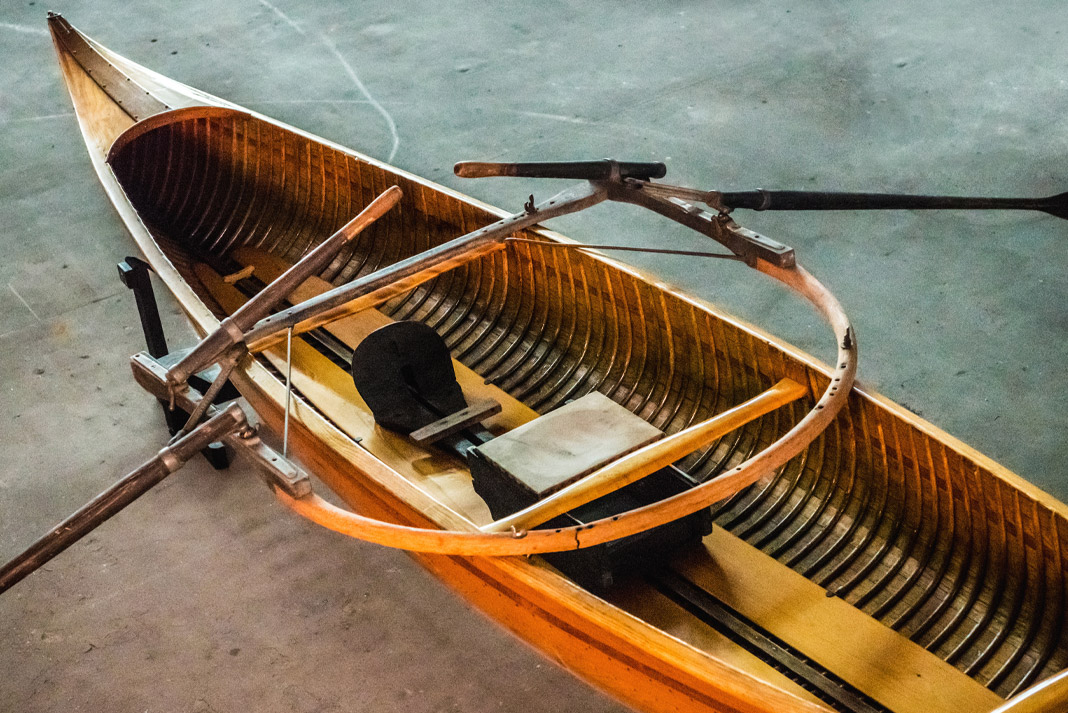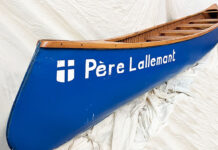Of all the things in the Canadian Canoe Museum, I’m often asked about my favorite item. It’s not a boat, strange as it may sound—although there are some very fine craft with stories yet to be discovered and some really crappy boats with amazing tales attached to them, and vice versa.
One of my absolute favorite artifacts is actually an aftermarket doodad. Specifically, it’s an item described in Letters Patent No. 169,277 and confirmed on October 26, 1875, at the United States Patent Office. It’s called: Improvement in Oars.
What is it about this gawky little spider of an invention that tickles me so? Let me explain with a brief story.
In her excellent book, Rowing to Latitude: Journeys Along the Arctic’s Edge, author Jill Fredston explores how she is a dyed-in-the-wool wilderness oar-puller.
“[I’m] firmly committed to rowing,” she writes, “which does not allow any part of my body to ride for free.” By contrast, her husband, Doug, is a sea kayaker. “[He is] oddly committed to seeing where he is going,” Fredston writes.
Lest you think this difference trivial, here’s a brief description of the situation from Fredston’s book: “Doug asserts rowing has made me dyslexic. I call the bow of the boat the back because it is behind me. Along the same lines, the stern is the front. I steer off of a terrain feature ‘ahead’ of me, like a notch on a ridge or a snow patch, despite the fact it recedes as I row.”

After something like 8,700 miles of sea travel in different boats, Doug eventually traded his sea kayak for an ocean-going shell and “reluctantly acknowledged the greater efficiency and speed afforded by a sliding seat and long oars. Doug and I skirmished a few times when he instructed me to go left or right, causing me to turn toward the obstacle we were trying to avoid. Seeking harmony, we adopted a color-coded system based on the red and green plastic collars on the oars. Now it is go green or go red.”
Among the other excellent tales Fredston writes is an occasion when they nearly come to blows over a disagreement on the water. Eventually, they realize the main difference in their perspective on what nearly killed them was that Jill, the rower, was facing one way and Doug, the kayaker, was observing from a position 180 degrees different than his wife.
The Improvement on Oars could have prevented this near field divorce.
It’s an assemblage of wood and metal affixing to the gunwales of a canoe to allow the occupant to row on a sliding seat and to do so facing in the direction of travel.
Ingenious.
Records at the Museum indicate the Peterborough Canoe Company built this little mechanical gem with Mr. William Lyman of Middlefield, Connecticut’s patented design. It came to the Museum through its first executive director Jack Matthews.
Matthews detailed in his description of the device, submitted at the time of the donation, that he purchased it with the understanding it had been used by the postmaster in the w—ee burg of Bobcaygeon, Ontario, between Sturgeon and Pigeon Lakes on the Trent-Severn Waterway, to deliver mail to cottagers around 1900.
History does not record if the postmaster’s mistress was a paddler but, had she been, they would have delivered the mail in perfect matrimonial harmony on account of Mr. Lyman’s cool little invention.
Some things never die, especially when they find a forever home in a museum.
James Raffan is an author, explorer and former executive director of the Canadian Canoe Museum.
You’ve got mail. Now delivered to you with patented FORWARD-FACING EFFICIENCY. | Photo: Samantha Moss








what would make the article 10x better, is a brief description or diagram of how this infernal rowing contraption works…